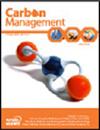促进进入土地部门碳减排项目:loc - c工具
IF 3.2
4区 环境科学与生态学
Q3 ENVIRONMENTAL SCIENCES
引用次数: 0
摘要
本文章由计算机程序翻译,如有差异,请以英文原文为准。
Facilitating entry to land sector carbon abatement projects: the LOOC-C tool
Abstract Carbon farming presents an opportunity for the land sector to generate income and transition to more sustainable land management practices. In Australia, establishing a carbon project and earning carbon credits is complex, with project proponents needing to satisfy eligibility requirements and adhere to rigorous measurement, verification, and reporting protocols of approved methods. To address these challenges, a human centered design (HCD) approach was used to deliver a digital solution, serving landowners’ needs related to method discovery and reconfiguring how the methodological and scientific complexity of abatement potentials was delivered. The solution, called LOOC-C (pronounced “Look-see”), supports the discovery of abatement methods that are available for a given land area and provides an initial estimate of the potential quantum of carbon sequestered/emitted and the nature of co-benefits associated with each eligible method. Reporting on LOOC-C development and its observed impact demonstrates the role that human centered digital tools have in promoting land management actions that are both sustainable and reasonable to undertake. It equally demonstrates the power of integrating environmental market and user requirements with a robust design methodology. With similar opportunities in environmental markets globally, additional applications of an HCD approach are proposed. Policy highlights In 2012, the Australian government established the Emissions Reduction Fund (ERF) to reward landowners (via awarding Australian Carbon Credit Units, or ACCUs) for the implementation of management practices that either sequester carbon and/or reduce emissions of greenhouse gases. Rigorous eligibility and method requirements are intended to provide confidence in abatement outcomes, but they introduce significant complexity that participants must overcome. 11 years later, uncertainties in the implementation and ACCU generation potential of ERF projects and implications on productivity/co-benefits have limited uptake and the quantum of ACCU generation of land sector enterprises. Digital tools that support the discovery of options and provide estimated potential outcomes, such as the LOOC-C tool described in this paper (https://looc-c.farm/), can generate interest and empowerment, helping to initiate decisions toward market participation. VIDEO ABSTRACT Facilitating Entry to Land Sector Carbon Abatement Projects: The LOOC-C Tool
求助全文
通过发布文献求助,成功后即可免费获取论文全文。
去求助
来源期刊

Carbon Management
ENVIRONMENTAL SCIENCES-
CiteScore
5.80
自引率
3.20%
发文量
35
期刊介绍:
Carbon Management is a scholarly peer-reviewed forum for insights from the diverse array of disciplines that enhance our understanding of carbon dioxide and other GHG interactions – from biology, ecology, chemistry and engineering to law, policy, economics and sociology.
The core aim of Carbon Management is it to examine the options and mechanisms for mitigating the causes and impacts of climate change, which includes mechanisms for reducing emissions and enhancing the removal of GHGs from the atmosphere, as well as metrics used to measure performance of options and mechanisms resulting from international treaties, domestic policies, local regulations, environmental markets, technologies, industrial efforts and consumer choices.
One key aim of the journal is to catalyse intellectual debate in an inclusive and scientific manner on the practical work of policy implementation related to the long-term effort of managing our global GHG emissions and impacts. Decisions made in the near future will have profound impacts on the global climate and biosphere. Carbon Management delivers research findings in an accessible format to inform decisions in the fields of research, education, management and environmental policy.
 求助内容:
求助内容: 应助结果提醒方式:
应助结果提醒方式:


